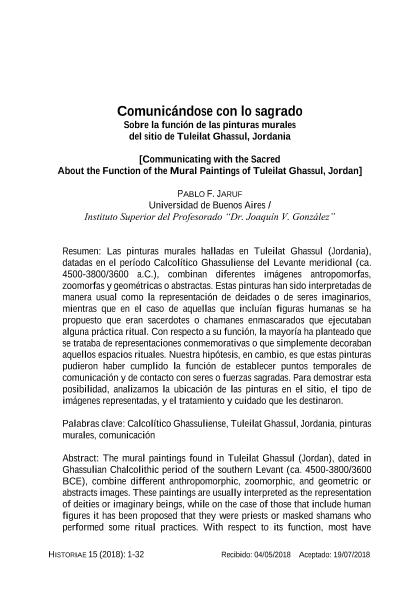Mostrar el registro sencillo del ítem
dc.contributor.author
Jaruf, Pablo Federico

dc.date.available
2019-11-01T18:11:34Z
dc.date.issued
2018-07
dc.identifier.citation
Jaruf, Pablo Federico; Comunicándose con la sagrado: sobre la función de las pinturas murales del sitio de Tuleilat Ghassul, Jordania; Grup d’Estudis Historiogràfics; Historiae; 15; 7-2018; 1-32
dc.identifier.issn
1697-5456
dc.identifier.uri
http://hdl.handle.net/11336/87832
dc.description.abstract
Las pinturas murales halladas en Tuleilat Ghassul (Jordania), datadas en el período Calcolítico Ghassuliense del Levante meridional (ca. 4500-3800/3600 a.C.), combinan diferentes imágenes antropomorfas, zoomorfas y geométricas o abstractas. Estas pinturas han sido interpretadas de manera usual como la representación de deidades o de seres imaginarios, mientras que en el caso de aquellas que incluían figuras humanas se ha propuesto que eran sacerdotes o chamanes enmascarados que ejecutaban alguna práctica ritual. Con respecto a su función, la mayoría ha planteado que se trataba de representaciones conmemorativas o que simplemente decoraban aquellos espacios rituales. Nuestra hipótesis, en cambio, es que estas pinturas pudieron haber cumplido la función de establecer puntos temporales de comunicación y de contacto con seres o fuerzas sagradas. Para demostrar esta posibilidad, analizamos la ubicación de las pinturas en el sitio, el tipo de imágenes representadas, y el tratamiento y cuidado que les destinaron.
dc.description.abstract
The mural paintings found in Tuleilat Ghassul (Jordan), dated in Ghassulian Chalcolithic period of the southern Levant (ca. 4500-3800/3600 BCE), combine different anthropomorphic, zoomorphic, and geometric or abstracts images. These paintings are usually interpreted as the representation of deities or imaginary beings, while on the case of those that include human figures it has been proposed that they were priests or masked shamans who performed some ritual practices. With respect to its function, most have argued that they were commemorative representations or that they simply decorated those ritual spaces. Our hyphothesis, instead, is that these paintings could have played the function of establishing temporary points of communication and contact with beings or sacred forces. To demostrate this possibility, we analize the location of the paintings on the site, the type of images represented, and the treatment and keeping that they were given.
dc.format
application/pdf
dc.language.iso
spa
dc.publisher
Grup d’Estudis Historiogràfics
dc.rights
info:eu-repo/semantics/openAccess
dc.rights.uri
https://creativecommons.org/licenses/by-nc-sa/2.5/ar/
dc.subject
CALCOLÌTICO
dc.subject
MURALES
dc.subject
JORDANIA
dc.subject
SAGRADO
dc.subject.classification
Historia

dc.subject.classification
Historia y Arqueología

dc.subject.classification
HUMANIDADES

dc.title
Comunicándose con la sagrado: sobre la función de las pinturas murales del sitio de Tuleilat Ghassul, Jordania
dc.title
Communicating with the Sacred: About the Function of the Mural Paintings of Tuleilat Ghassul, Jordan
dc.type
info:eu-repo/semantics/article
dc.type
info:ar-repo/semantics/artículo
dc.type
info:eu-repo/semantics/publishedVersion
dc.date.updated
2019-10-08T13:09:02Z
dc.journal.number
15
dc.journal.pagination
1-32
dc.journal.pais
España

dc.journal.ciudad
Barcelona
dc.description.fil
Fil: Jaruf, Pablo Federico. Consejo Nacional de Investigaciones Científicas y Técnicas. Oficina de Coordinación Administrativa Saavedra 15. Instituto Multidisciplinario de Historia y Ciencias Humanas; Argentina. Universidad de Buenos Aires. Facultad de Filosofía y Letras. Departamento de Historia; Argentina
dc.journal.title
Historiae
dc.relation.alternativeid
info:eu-repo/semantics/altIdentifier/url/https://dialnet.unirioja.es/servlet/articulo?codigo=6806197
Archivos asociados
